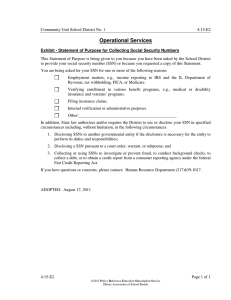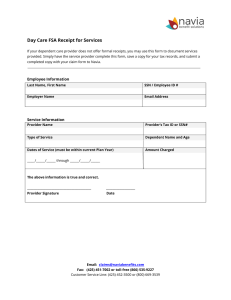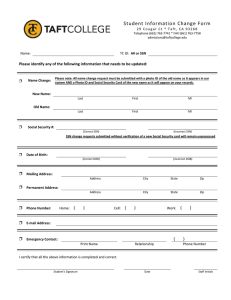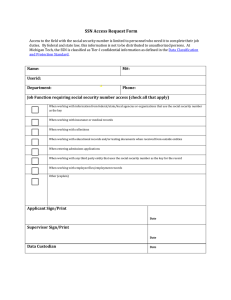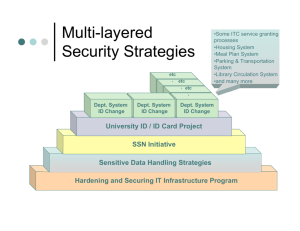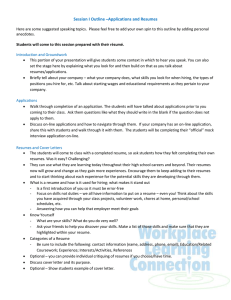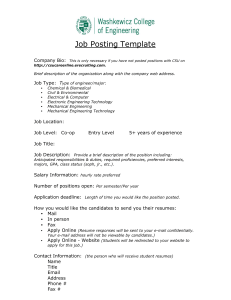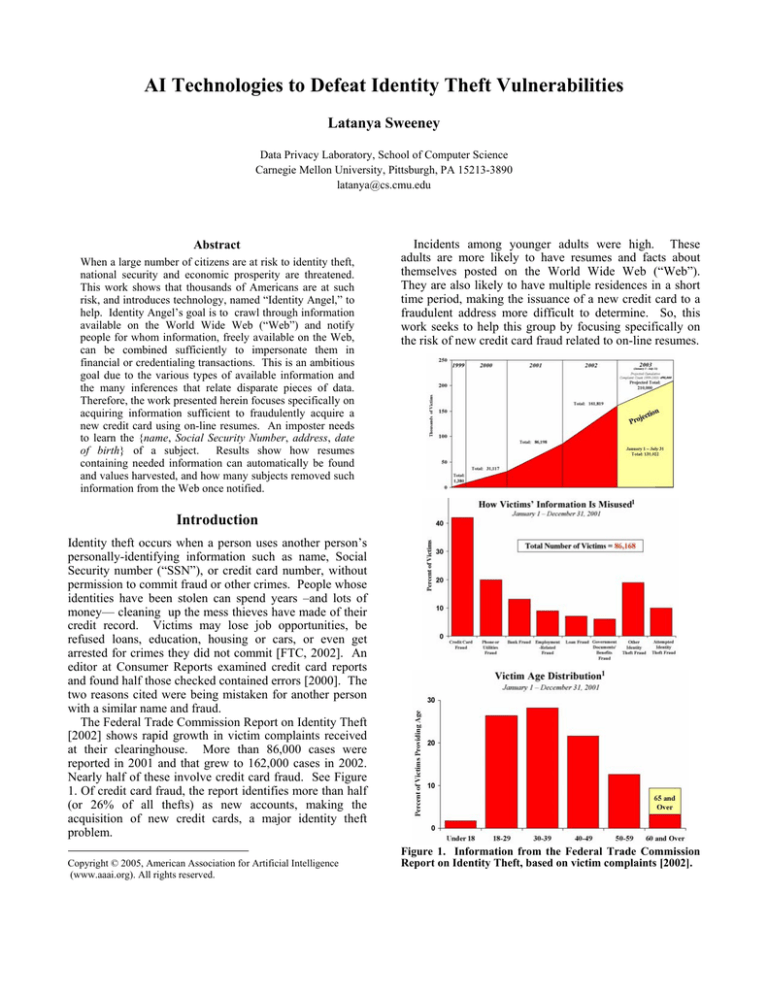
AI Technologies to Defeat Identity Theft Vulnerabilities
Latanya Sweeney
Data Privacy Laboratory, School of Computer Science
Carnegie Mellon University, Pittsburgh, PA 15213-3890
latanya@cs.cmu.edu
Abstract
1
When a large number of citizens are at risk to identity theft,
national security and economic prosperity are threatened.
This work shows that thousands of Americans are at such
risk, and introduces technology, named “Identity Angel,” to
help. Identity Angel’s goal is to crawl through information
available on the World Wide Web (“Web”) and notify
people for whom information, freely available on the Web,
can be combined sufficiently to impersonate them in
financial or credentialing transactions. This is an ambitious
goal due to the various types of available information and
the many inferences that relate disparate pieces of data.
Therefore, the work presented herein focuses specifically on
acquiring information sufficient to fraudulently acquire a
new credit card using on-line resumes. An imposter needs
to learn the {name, Social Security Number, address, date
of birth} of a subject. Results show how resumes
containing needed information can automatically be found
and values harvested, and how many subjects removed such
information from the Web once notified.
Incidents among younger adults were high. These
adults are more likely to have resumes and facts about
themselves posted on the World Wide Web (“Web”).
They are also likely to have multiple residences in a short
time period, making the issuance of a new credit card to a
fraudulent address more difficult to determine. So, this
work seeks to help this group by focusing specifically on
the risk of new credit card fraud related to on-line resumes.
Introduction
Identity theft occurs when a person uses another person’s
personally-identifying information such as name, Social
Security number (“SSN”), or credit card number, without
permission to commit fraud or other crimes. People whose
identities have been stolen can spend years –and lots of
money— cleaning up the mess thieves have made of their
credit record. Victims may lose job opportunities, be
refused loans, education, housing or cars, or even get
arrested for crimes they did not commit [FTC, 2002]. An
editor at Consumer Reports examined credit card reports
and found half those checked contained errors [2000]. The
two reasons cited were being mistaken for another person
with a similar name and fraud.
The Federal Trade Commission Report on Identity Theft
[2002] shows rapid growth in victim complaints received
at their clearinghouse. More than 86,000 cases were
reported in 2001 and that grew to 162,000 cases in 2002.
Nearly half of these involve credit card fraud. See Figure
1. Of credit card fraud, the report identifies more than half
(or 26% of all thefts) as new accounts, making the
acquisition of new credit cards, a major identity theft
problem.
Copyright © 2005, American Association for Artificial Intelligence
(www.aaai.org). All rights reserved.
Figure 1. Information from the Federal Trade Commission
Report on Identity Theft, based on victim complaints [2002].
The California-based Foundation for Taxpayer and
Consumer Rights said for $26 each it was able to purchase
the Social Security numbers and home addresses for Tenet,
Ashcroft and other top Bush administration officials
[Associated Press, 2003].
In contrast, the work reported herein addresses how to
obtain SSNs for larger numbers of ordinary people using
easily accessible and free on-line sources. In terms of risk,
the less expensive sensitive information is to obtain and
the greater the number of people having access to it,
usually the greater the opportunity for abuse. Therefore,
this work concerns SSNs available freely on the Web.
In 2003, the U.S. General Accounting Office identified
SSN vulnerabilities as ripe for exploitation by terrorists
[and other criminals], making SSN problems a serious
concern to homeland security and a grave threat to the
country’s economic prosperity. These groups may gain
funds for their activities while simultaneously causing
havoc to the country’s economy and citizens. The risks are
real, yet poorly understood. The lack of scientific
examination deprives society of possible benefits that may
be realized by innovative technology. This work is
proposed as one such technology.
Methods and Prior Work
Figure 2. An on-line credit card application. Requested
demographic information is shown and also includes phone
and address (not shown). In student applications, the name of
the college and expected year of graduation is also requested.
New Credit Card Fraud
In the acquisition of new credit cards, the person is only
represented by the information provided on the application.
The basic Information necessary for a credit card
application is: {Name, SSN, Address, Date of birth,
Mother’s maiden name}; see Figure 2 for an example.
How might an imposter gather the necessary information
freely over the web? Mother’s maiden name is used as a
challenge question “after” the credit card is issued and not
verified beforehand. The original address needs to be
known, so a change of address can be included with the
fraudulent application.
Name searches on phone
directories can often be used to find addresses. Several
websites provide a date of birth (“DOB”), given a person’s
name (e.g., anybirthday.com). So, the most sensitive
information is the SSN and its matching name.
Social Security Numbers
A key element to fraudulently acquiring a new credit card
is the Social Security number. SSNs have evolved into
national identifying numbers for individuals living and
working in the United States. They are essential to
identifying, recognizing, and authenticating people in
health, financial, legal, and educational information. Some
people might falsely believe that access to SSNs, while
available within many financial, health, employment, and
government institutions, are not publicly available.
Acquiring information sufficient to fraudulently obtain a
new credit card using on-line resumes consists of locating
on-line resumes, extracting information and emailing
subjects. See Figure 3. The methods used to accomplish
these tasks builds on the prior work described below.
In 2004, Sweeney introduced a system that locates online lists of names of people (“rosters”). Rosters are
evasive to search engine retrieval because they do not lend
themselves to keyword lookup. Using expressions such as
“employees” or “students” returns hundred of pages, but
finding the rosters among them previously required many
hours of human inspection. Sweeney’s approach (“filtered
searching”) executes a predicate function on each page
retrieved from keyword searches to determine whether a
page is an instance of the kind of page sought (e.g., a
roster). The work reported herein uses filtered searching
to locate on-line resumes.
In 1996, Sweeney used a system of entity detectors in a
black board architecture to extract personally-identifying
information from text files (e.g., letters and clinical notes).
To date, the system continues to out-perform statistical and
linguistic based approaches. The work reported herein
also uses entity detectors, which in this case, are simple
regular expressions, to identify instances of dates of birth,
email addresses and SSNs appearing in resumes.
1
2
3
Locate on-line resumes (using Filtered Searching)
Extract sensitive values (using regular expressions)
Email subjects about their risks
Figure 3. Three processing steps required.
Results
Results show how on-line resumes containing needed
information can automatically be found and values
extracted and how some subjects protected such
information from the Web once notified.
Richard Allen Brown. PO Box 782. Kayenta, AZ 86033.
Home Telephone-520-697-3513. NAU Telephone-520-523-4099.
DOB: 03-10-77. SSN: 527-71 ...
dana.ucc.nau.edu/~rab39/RAB%20Resume.doc
…2843. DOB: 10-10-48 New Britain, CT 06050-4010. F: (860) 8323753. SSN: 461-84-… H: (203) 740-7255: (203) 561-8674.
Education. Ph.D. www.math.ccsu.edu/vaden-goad/resume.htm
Scot Patrick Lytle. Home: (301)-249-5330 2116 Blaz Court School:
(410)-455-1662 Upper Marlboro, MD 20772 SSN: 578-90-…
userpages.umbc.edu/~slytle1/resume.html
Figure 4. Sample on-line resumes that include SSNs, Two of
the resumes include dates of birth. All three include address
and phone number. SSNs have been truncated for this
writing but were fully available.
Materials
Experiments were based on: (1) FilteredSearch Java code;
(2) two resulting resume databases; and, (3) entity
detectors, as described below.
FilteredSearch. Java code that uses the Google API to
perform a series of searches, pruning out duplicate pages.
Resume Databases. Using FilteredSearch on keywords
{“resumes”, “vitae”}, the first n distinct actual resumes
containing SSNs were compiled into a database. DBA has
150 resumes from December 2003 and DBB has 75
resumes from December 2004 (excluding any in DBA).
Detectors. Regular expressions that identify ways of
writing dates, SSNs and email addresses along with
preceding heading such as “dob”.
SSNwatch. To confirm whether a provided number was
actually an SSN, the SSNwatch validation server was used
to confirm that the number was likely to be valid (Sweeney,
2004).
Experiment 1: Finding Sensitive Resumes
Using FilteredSearch with a predicate function, which
confirmed whether a retrieved page had format (using
layout cues) and content (using headings) consistent with
that of a resume or vitae, and included an SSN (using the
appearance of 9 digits with and without an SSN heading
and with and without dashes appearing between the digits.
More than 2000 webpages of suspect resumes were filtered
to produce DBA and similarly for DBB.
Based on exhaustive manual inspection of results and
using the SSNwatch Validation Server, the following
results were found. Of the 150 resumes in DBA, 140 (or
93%) had complete 9-digit SSNs. 10 resumes had partial,
invalid, or some other country’s SSN. All of the 75
resumes in DBB had 9 digit SSNs.
Experiment 2: Extracting Sensitive Information
Applying Detectors to DBA, and then manually inspecting
each resume, provided the following results. All email
addresses (113 of 113 or 100%) were found. The ‘@’ and
dot (.) notation worked well. All dates of birth (110 of 110
or 100%) were found, but some dates, which were not
dates of birth were incorrectly reported as such; this
happened in 20 cases (but only 7 where the proper DOB
was not also found). SSN results were reported above.
In terms of combinations: 104 (or 69%) resumes had
{SSN, DOB}; 105 (or 70%) had {SSN, email}, and 76 (or
51%) had {SSN, DOB, email}.
Experiment 3: Behavioral Impact
A single email message was sent to each of the 105 people
in DBA having {SSN, email} alerting them to the risk. A
year later, 102 (or 68% of all of DBA) no longer had the
information available. In DBB, 46 were notified, and
within a month, 42 (or 55% of all of DBB) no longer had
the information publicly available.
Discussion
Imagine a benevolent program that emails people for
whom information, freely available on the Web can be
combined sufficiently to impersonate them in financial
transactions. This is the ambitious goal of “Identity
Angel.” The work reported herein focused on a subproblem of Identity Angel –namely, acquiring information
sufficient to fraudulently acquire a new credit card using
on-line resumes. This work demonstrated the viability of
this approach.
Acknowledgements
Thanks to Sylvia Barrett, Kishore Madhava, Yea-Wen
Yang and Nicholas Lynn for assistance.
References
Consumer Reports, July 2000.
Social Security numbers sold on Web. Associated Press, 8/2003.
Sweeney, L. Finding Lists of People on the Web. ACM
Computers and Society, 34 (1) April 2004.
Sweeney, L. Replacing Personally-Identifying Information in
Medical Records, the Scrub System. Proceedings, Journal of the
American Medical Informatics Association. 1996.
Sweeney, L. SSNwatch Validation Server, 2004
<privacy.cs.cmu.edu/dataprivacy/projects/ssnwatch/index.html>.
United States Federal Trade Commission, Report on Identity
Theft, Victim Complaint Data: Figures and Trends JanuaryDecember 2001, Federal Printing Office, Washington, DC: 2002.
United States General Accounting Office, Improved SSN
Verification and Exchange of States’ Driver Records Would
Enhance Identity Verification, Federal Printing Office,
Washington, DC: 2003.

